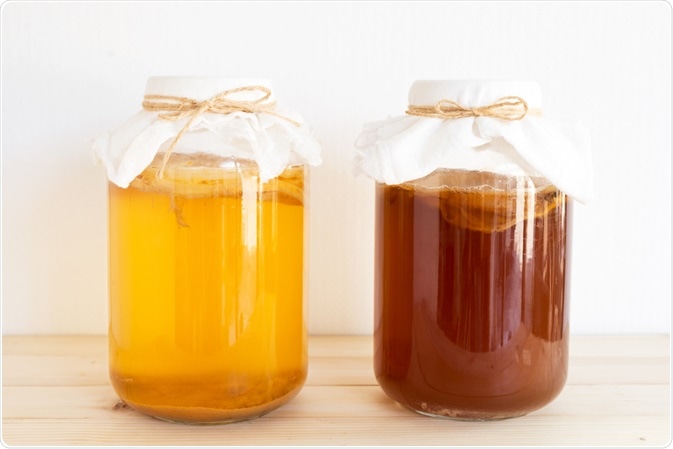Kombucha is a fermented drink (also known as ‘Kombucha Tea’) that is thought to have originated in China and was first recorded as being a beverage in 221BC.

P-fotography | Shutterstock
Kombucha is thought to have a variety of health benefits and has had a recent surge in popularity. It is sweet and slightly acidic in taste and has a very low alcohol content.
How is kombucha made?
This hot drink is made by fermenting what used to be called ‘the Manchurian mushroom’. However, It has since been discovered that it is not a mushroom but a symbiotic combination of acetic acid bacteria and a type of yeast. This ‘symbiotic culture of bacteria and yeast’ known as a SCOBY culture or ‘pellicle’ is mainly comprised of bacterial cellulose.
.jpg) Healthy SCOBY culture for kombucha production. (P-fotography | Shutterstock)
Healthy SCOBY culture for kombucha production. (P-fotography | Shutterstock)
The yeast-bacteria combination culture is made into ‘tea-fungus’. After this is left to brew and ferment inside either green tea or black tea with sugar, it leaves behind the two portions of kombucha tea: the floating cellulosic pellicle layer, and a sour liquid broth at the bottom.
As kombucha cultures are grown, they form a large, flat colony on top of the tea. Once this colony is left to ferment for approximately ten days or more, the original ‘mother’ culture begins to produce a secondary layer – appropriately named ‘baby’ cultures. While all of this is happening, the tea begins to fully ferment, which produces the acidic, carbonated beverage.
Quality assurance for kombucha
High-throughput analysis
As Kombucha is home-brewed, biological/chemical analysis methods are rarely used – it is usually brewed until it ‘looks’ ready. However, a 2014 study did some culture-independent, high-throughput sequencing analysis on the fungal and bacterial populations of five different pellicles, as well as two different resulting kombucha brews.
This analysis established that the most common bacteria type present was Gluconacetobacter, which makes up approximately >85% in most of the samples, while only trace numbers of Acetobacter being observed (<2%). Lactobacillus populations were also identified, with a presence of up to 30%.
Furthermore, a number of sub-dominant types of bacteria, not previously thought to have been associated with kombucha, were also observed in these samples.
The yeast populations were found to mainly consist of Zygosaccharomyces, at a concentration of around 95% – with a greater diversity of fungus being present in the pellicle. This analysis identified numerous yeast species that were not previously thought to be present in kombucha.
Concern for pathogenic contamination in kombucha
With these teas being commonly brewed in people’s homes, there is a concern that harmful, pathogenic contamination could occur. However, this study found that the naturally acidic pH, on top of the slight alcohol content of kombucha generated under these home-brewing conditions, combined with the microbiological competition involving the indigenous microbial population provided by the cellulosic pellicle, is sufficient to effectively limit the external contamination from undesirable bacteria.
Health benefits of kombucha
It has long been believed that drinking kombucha has many health benefits, ranging from treating the common cold, curing cancer, and improving the immune system. However, there have been no human clinical trials surrounding the health benefits surrounding the consumption of this beverage.
Existing reports suggest that the health benefits are the same as those provided by drinking regular black tea – but more studies are required before any conclusions can be made surrounding the alleged benefits of drinking kombucha tea.
Sources
- www.sciencedirect.com/science/article/abs/pii/S0269915X00800348
- https://onlinelibrary.wiley.com/doi/full/10.1111/1541-4337.12073
- https://link.springer.com/article/10.1007/BF00128667
- https://www.ncbi.nlm.nih.gov/pubmed/24290641
Further Reading
- All Microbiology Content
- Gram Negative Bacteria
- Differentiating Between Microbial Species
- Quorum Sensing and Pseudomonas aeruginosa
- Single Cell Microbiology
Last Updated: Nov 20, 2018
Written by
Phoebe Hinton-Sheley
Phoebe Hinton-Sheley has a B.Sc. (Class I Hons) in Microbiology from the University of Wolverhampton. Due to her background and interests, Phoebe mostly writes for the Life Sciences side of News-Medical, focussing on Microbiology and related techniques and diseases. However, she also enjoys writing about topics along the lines of Genetics, Molecular Biology, and Biochemistry.
Source: Read Full Article